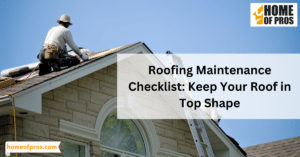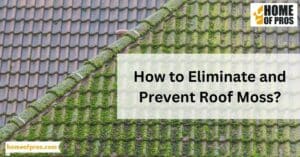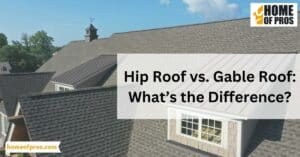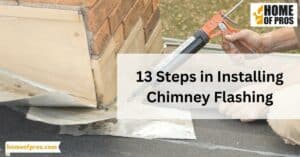When it comes to flat roofing for residential properties, there are several key considerations to keep in mind. Factors such as drainage, insulation, material durability, and maintenance requirements should be taken into account. Proper solutions involve utilizing high-quality materials, incorporating efficient drainage systems, and ensuring regular inspections and maintenance to prolong the lifespan of the roof.
In this post, we’ll dive into the world of flat roofing – illuminating its unique characteristics, discussing key considerations, and exploring practical solutions. Whether you’re a seasoned homeowner or a newbie to the property game, we aim to equip you with the knowledge to make informed decisions on your roofing needs.

What is Flat Roofing
Flat roofing is a popular choice for many homes and commercial buildings due to its practicality and modern aesthetic. Unlike sloped roofs, the flat design allows for more efficient use of space. It makes it perfect for rooftop gardens, solar panels, and even outdoor entertainment areas. However, flat roofing requires careful planning and execution to ensure durability and longevity.
Proper installation and maintenance are key to preventing leaks and water damage. It’s important to work with a professional roofing contractor who understands the complexities of flat roofing. Also, can offer expert solutions. With the right care and attention, a flat roof can provide a sleek and functional design for many years to come.
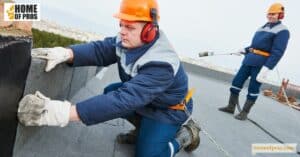
Considerations for Choosing a Flat Roof for Your Home
There are many factors to consider especially if you’re opting for a flat roof. Unlike pitched roofs, flat roofs come with their unique set of challenges, which require careful consideration. For starters, you need to assess the pitch of your home’s roofline. Determine your budget and factor in your local weather conditions. Other critical considerations include the materials and insulation you use, the size of your roof, and its intended use. Making the right choice can ensure your household is well protected from the elements while providing you with comfortable living spaces.
Type of Material and Installation Process
When it comes to selecting a flat roof for your home, one of the crucial factors to consider is the type of material and installation process. There are various types of materials available for flat roofs. These include such as PVC, TPO, EPDM, and Modified Bitumen. Each material has its unique features and benefits, including durability, heat resistance, and cost-effectiveness. Choosing the right installation process is equally important to ensure your roof’s longevity and performance.
The most common flat roof installation methods are fully adhered, mechanically attached, and ballasted. A fully adhered system involves gluing the roofing material directly to the roof deck. While a mechanically attached system utilizes fasteners to secure the material. A ballasted system involves using large rocks or gravel to hold the membrane in place. Understanding the different factors involved in selecting a flat roof material and installation. They can help you make an informed decision and ensure that your home’s roof is in excellent condition for years to come.
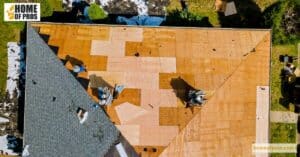
Cost, Maintenance and Life Expectancy Requirements
Choosing the right type of roofing for your home is an important decision that can impact your wallet and the longevity of your property. Flat roofs are a popular option due to their sleek and modern appearance, but it is important to consider various factors such as cost, maintenance, and life expectancy before making a commitment. The cost of installation largely depends on the materials used and the size of the roof. However, maintenance also plays a vital role in the overall cost of ownership.
Flat roofs require regular inspections and prompt repairs to prevent damages that could shorten their lifespan. Life expectancy is another crucial factor to consider when choosing flat roofs. Most flat roofs last between 10 and 20 years, depending on the materials used, installation quality, and level of maintenance. By assessing these three factors, you can make an informed decision on the best type of flat roof for your home that will meet your needs and budget while ensuring its longevity.

Solutions for Different Problems when Installing a Flat Roof
Flat roofs can be a cost-effective and energy-efficient option for residential and commercial buildings alike. However, the installation process can pose a variety of challenges. Fortunately, there are several solutions available to address the most common problems that arise during the process. Whether you’re dealing with drainage issues, leaks, or other concerns, working with a professional roofing contractor can help ensure that your flat roof is properly installed and maintained for years of reliable performance. With the right solutions and expert support, you can enjoy all the benefits of a flat roof without worrying about the hassles that come with it.
Waterproofing and Drainage Considerations
When it comes to installing a flat roof, waterproofing and drainage considerations are essential to ensure the longevity and effectiveness of the structure. One common issue is standing water which can lead to deterioration and leaks. A solution to this is to install a tapered system that allows for proper drainage. Another problem is the penetration of water through seams or joints. This can be prevented by using a seamless roofing membrane or by sealing all seams and joints effectively. Adequate insulation is also necessary to prevent condensation, which can result in water damage and mold growth.

Strategies to Insulate and Cool the Building
Ensuring that a flat roof is insulated and kept cool can be a tricky and costly process, but it is necessary for maintaining a comfortable, energy-efficient living or working space. To combat problems such as heat absorption, improper ventilation, and water damage, several strategies have emerged as effective solutions. Properly sealing the roof with a waterproof membrane, adding insulation, and incorporating both intake and exhaust ventilation systems are all effective ways to combat heat absorption and prevent water damage.
Additionally, reflective roofing materials can help reduce heat gain and cool down the space, while green roofs provide natural insulation and aid in cooling. With a range of strategies available, it’s important to consult with a professional to determine the best solution for your particular building.
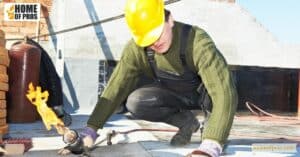
UV Protection Techniques
As the popularity of flat roofs continues to rise, so does the need for effective protection against UV damage. Luckily, there are several techniques available to solve different problems that arise during installation. For roofs with low traffic, a simple coating of reflective paint can often do the trick, reflecting the UV rays and keeping the surface cooler.
For high-traffic or more heavily used roofs, a thicker coating of elastomeric coating is recommended, providing a durable, flexible layer that can withstand foot traffic and other wear and tear. In addition, the installation of a green roof or solar panels can provide both UV protection and energy-saving benefits. When it comes to protecting your flat roof from UV damage, there’s no shortage of options available.
In Conclusion
It is clear that homeowners who are considering flat roofing for their residential properties must carefully weigh various considerations and seek expert solutions to ensure that the installation and maintenance are well executed. Whether one is erecting a new structure or replacing an existing roof, it is important to be aware of the various flat roofing options available, such as TPO, EPDM, PVC, and modified bitumen. One must also pay attention to factors such as slope, drainage, insulation, ventilation, and environmental conditions.
Proper installation, regular inspections, and timely repairs are crucial to ensuring the longevity and effectiveness of a flat roof. By following these guidelines, homeowners can be confident in achieving a sturdy and durable flat roofing solution for their residential properties.



